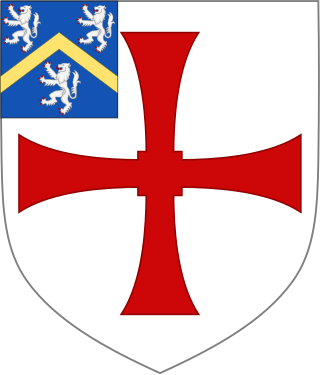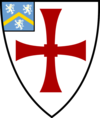
North East England is one of nine official regions of England at the first level of ITL for statistical purposes. The region has three current administrative levels below the region level in the region: combined authority, unitary authority or metropolitan borough, and civil parishes. They are also multiple divisions without administrative functions; ceremonial county, emergency services, built-up areas and historic county. The largest settlements in the region are Newcastle upon Tyne, Middlesbrough, Sunderland, Gateshead, Darlington, Hartlepool and Durham.

Durham is a cathedral city and civil parish in the county of Durham, England. It is the county town and contains the headquarters of Durham County Council, the unitary authority which governs the district of County Durham. It had a population of 48,069 at the 2011 Census.
Durham Students' Union, operating as Durham SU, is the students' union of Durham University in Durham, England. It is an organisation, originally set up as the Durham Colleges Students’ Representative Council in 1899 and renamed in 1969, with the intention of representing and providing welfare and services for the students of the University of Durham.

Hilda of Whitby was a saint of the early Church in Britain. She was the founder and first abbess of the monastery at Whitby which was chosen as the venue for the Synod of Whitby in 664. An important figure in the Christianisation of Anglo-Saxon England, she was abbess in several convents and recognised for the wisdom that drew kings to her for advice.

William Van Mildert was the bishop of Durham (1826–1836), and the last to rule the county palatine of Durham. He was also one of the founders of the University of Durham, where he is commemorated in the names of Van Mildert College, founded in 1965, and the Van Mildert Professor of Divinity.

St Cuthbert's Society, colloquially known as Cuth's, is a college of Durham University. It was founded in 1888 for students who were not attached to the existing colleges. St Cuthbert's Society is a Bailey college, based on Durham's peninsula next to the River Wear, although it also has other accommodation a few minutes' walk away in Old Elvet.

St Aidan's College is a college of the University of Durham in England. It had its origins in 1895 as the association of women home students, formalised in 1947 as St Aidan's Society. In 1961, it became a full college of the university, and in 1964 moved to new modernist buildings on Elvet Hill designed by Sir Basil Spence.

Ustinov College is the largest college of Durham University, located in Durham, North East England. Founded as the Graduate Society in 1965, it became a college in 2003 and was named after then-chancellor, Sir Peter Ustinov. Formerly at the Howlands Farm site at the top of Elvet Hill, in 2017 the college relocated to the Sheraton Park site in Neville's Cross.

Van Mildert College is a college of Durham University in England. Founded in 1965, it takes its name from William Van Mildert, Prince-Bishop of Durham from 1826 to 1836 and a leading figure in the University's 1832 foundation. Originally an all-male college, it became co-educational in 1972 with the admission of female undergraduates.

The College of St Hild and St Bede, commonly known as Hild Bede, is a college of Durham University in England. It is the university's second largest collegiate body, with over 1000 students. The co-educational college was formed in 1975 following the merger of two much older single-sex institutions, the College of the Venerable Bede for men and St Hild's College for women.

Ushaw College is a former Catholic seminary near the village of Ushaw Moor, County Durham, England, which is now a heritage and cultural tourist attraction. The college is known for its Georgian and Victorian Gothic architecture and listed nineteenth-century chapels. The college now hosts a programme of art exhibitions, music and theatre events, alongside tearooms and a café.

Stephenson College is a college of the University of Durham in England.
Colleges within universities in the United Kingdom can be divided into two broad categories: those in federal universities such as the University of London, which are primarily teaching institutions joined in a federation, and residential colleges in universities following the traditional collegiate pattern of Oxford and Cambridge, which may have academic responsibilities but are primarily residential and social. The legal status of colleges varies widely, both with regard to their corporate status and their status as educational bodies. London colleges are all considered 'recognised bodies' with the power to confer University of London degrees and, in many cases, their own degrees. Colleges of Oxford, Cambridge, Durham and the University of the Highlands and Islands (UHI) are 'listed bodies', as "bodies that appear to the Secretary of State to be constituent colleges, schools, halls or other institutions of a university". Colleges of the plate glass universities of Kent, Lancaster and York, along with those of the University of Roehampton and the University of the Arts London do not have this legal recognition. Colleges of Oxford, Cambridge, London, and UHI, and the "recognised colleges" and "licensed halls" of Durham, are separate corporations, while the colleges of other universities, the "maintained colleges" of Durham, and the "societies of the university" at Oxford are parts of their parent universities and do not have independent corporate existence.
St Joseph's Catholic Academy is a coeducational Roman Catholic secondary school with academy status, located in Hebburn, South Tyneside, England.

Fenwick Justin John Lawson, ARCA is an English sculptor based in the north-east of England.
A head of college or head of house is the head or senior member of a college within a collegiate university. The title used varies between colleges, including dean, master, president, principal, provost, rector and warden.

The history of Durham University spans over 190 years since it was founded by Act of Parliament. King William IV granted royal assent to the Act on 4 July 1832, and granted the university a royal charter on 1 June 1837, incorporating it and confirming its constitution. The university awarded its first degrees on 8 June 1837. It describes itself as the third-oldest university in England and is listed by the European University Association as one of Europe's oldest hundred universities in continuous operation.

Durham University is a collegiate public research university in Durham, England, founded by an Act of Parliament in 1832 and incorporated by royal charter in 1837. It was the first recognised university to open in England for more than 600 years, after Oxford and Cambridge, and is thus the third-oldest university in England. As a collegiate university, its main functions are divided between the academic departments of the university and its 17 colleges. In general, the departments perform research and provide teaching to students, while the colleges are responsible for their domestic arrangements and welfare.

Queen's Campus is a site owned by the University of Durham located in Thornaby-on-Tees in the borough of Stockton-on-Tees, now home to the Durham University International Study Centre.













































